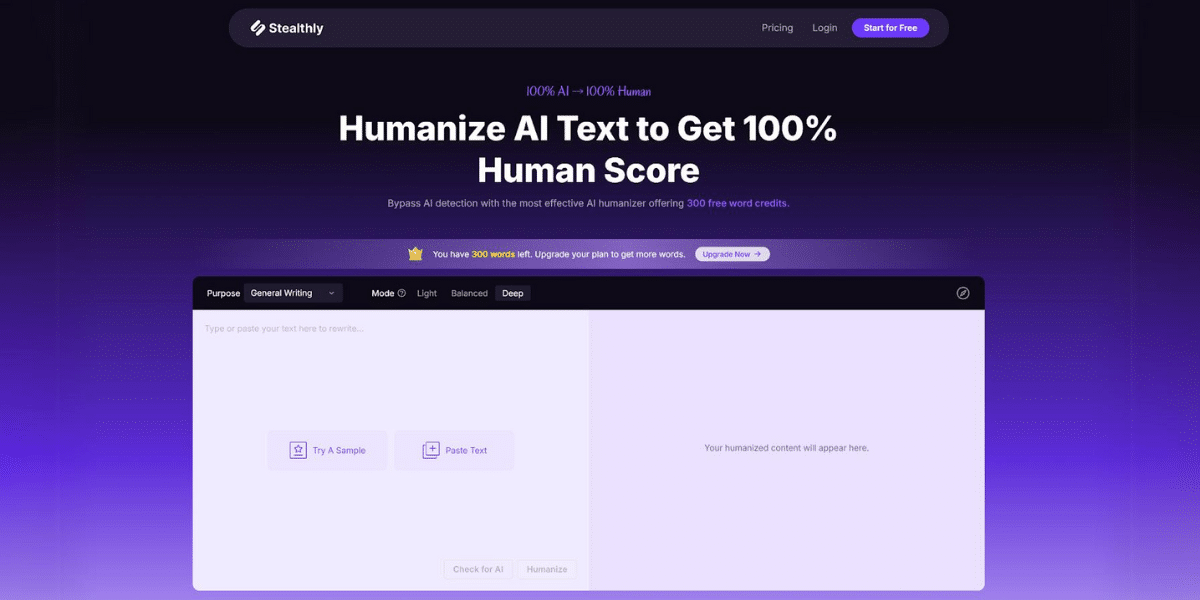In the ever-evolving landscape of digital content creation, tools that enhance the quality and authenticity of AI-generated text are gaining traction. One such tool is Stealthly, an AI humanizer designed to modify AI-generated text, making it more human-like and undetectable. This review explores the features, functionality, and potential of Stealthly as an effective solution for those seeking to humanize AI text.
What is an AI Humanizer?
AI humanizer is a tool that modifies content produced by AI, injecting human nuances, idioms, and natural language patterns. The goal is to produce text that not only reads like it was written by a human but also bypasses various AI detection systems. Stealthly AI positions itself as a leading player in humanizing AI text, employing advanced algorithms to achieve high success rates in humanizing AI text.
Why Humanize AI Text?
With the rise of AI-generated content, there are growing concerns regarding authenticity and originality. Educational institutions, content creators, and businesses require tools that ensure compliance with ethical standards. Humanizing AI text can help:
- Reduce the risk of plagiarism.
- Maintain academic integrity.
- Enhance content quality for better readability and engagement.
Stealthly addresses these concerns by providing a platform that seamlessly integrates human-like qualities into AI text.
Features of Stealthly
High Success Rate
One of the notable features of Stealthly is its capability to humanize text, making it less detectable by various AI detection systems, including those like Turnitin and Originality.ai. This functionality is helpful for students and professionals who require polished writing to achieve their goals.
Advanced Algorithms
Stealthly employs sophisticated deep learning algorithms that have been trained on a vast dataset of over significant number of texts. This extensive training allows the tool to identify specific elements in AI-generated content that may sound robotic or unnatural. By understanding these nuances, Stealthly can effectively rewrite text to incorporate a more human touch.
User-Friendly Interface
The interface of Stealthly is designed to be intuitive, catering to users of all technical backgrounds. The process of humanizing AI text is straightforward: users simply paste their text into the tool, click a button, and receive a revised version that adheres to the desired level of humanization. This ease of use makes Stealthly accessible to a wide audience, from students to professional writers.
Plagiarism-Free Guarantee
Stealthly emphasizes its commitment to producing original content. Each humanized output is designed to be free from plagiarism, addressing the concerns of users who must ensure their work adheres to academic and professional standards. This feature is particularly appealing to students who face stringent academic integrity policies.
Multi-Language Support
In an increasingly globalized world, the ability to humanize content in various languages is a significant advantage. Stealthly claims to support multiple languages, making it a versatile tool for businesses and individuals operating in diverse linguistic contexts. This feature enhances its usability for international users.
The Process of Humanizing AI Text
Step-by-Step Guide
1. Input AI-Generated Text: Users begin by pasting their AI-generated content into the Stealthly platform.
2. Select Humanization Mode: Stealthly offers different humanization modes—light, balanced, and deep—allowing users to choose the level of rewriting they prefer based on their specific needs.
3. Click Humanize: After selecting the desired mode, users simply click the humanize button to initiate the process.
4. Receive Humanized Content: The tool generates a revised version of the text, which aims to bypass AI detection while maintaining the original meaning and intent.
Modes of Humanization
- Light Mode: This mode offers minimal changes, suitable for users who want to retain much of the original text while enhancing its readability.
- Balanced Mode: This option strikes a middle ground, making moderate changes to improve the text without overhauling it completely.
- Deep Mode: For users looking for a comprehensive rewrite, deep mode applies extensive modifications, significantly altering the structure and style of the original content.
Practical Applications of Stealthly

Academic Writing
Students can greatly benefit from using Stealthly, especially in environments where originality is paramount. The tool allows students to take AI-generated essays and enhance them to meet academic standards. By humanizing their work, they can avoid false positives in detection systems and adhere to integrity policies.
Content Creation for Businesses
For marketers and content creators, the need for engaging and authentic content is critical. Stealthly assists in refining AI-generated marketing copy, blog posts, and social media content, ensuring that the output is not only human-like but also optimized for reader engagement.
SEO Considerations
Search engine optimization (SEO) is a crucial factor for online visibility. Google and other search engines are increasingly wary of low-quality or spammy AI content. By using Stealthly, webmasters can enhance their AI-generated content, reducing the likelihood of being penalized by search engines. The tool helps maintain high-quality standards that improve overall content effectiveness.
Bypassing AI Detection
How Does Stealthly Work?
Stealthly’s algorithms analyze the input text for characteristics commonly associated with AI writing, such as repetitive structures, unnatural phrasing, and lack of emotional nuance. By making targeted adjustments, the tool effectively alters these elements to create a version that feels more authentic.
Success Against AI Detectors
The ability to bypass AI detection systems is one of Stealthly’s strongest selling points. The tool has undergone rigorous testing against popular detectors, ensuring that its outputs are genuinely undetectable. This capability is particularly appealing to users concerned about the implications of using AI-generated content in academic or professional settings.
Limitations and Considerations
Potential Over-Reliance
While tools like Stealthly provide valuable support, there is a risk of over-reliance on AI humanizers. Users should maintain a balance between utilizing technology and developing their own writing skills. Relying solely on automated tools may hinder personal growth in writing and critical thinking.
Quality of Output
Although Stealthly aims for high-quality output, the effectiveness can vary based on the complexity of the original text. Users should review the humanized content carefully to ensure it meets their expectations and retains the intended message.
Ethical Implications
The use of AI humanizers raises ethical questions, especially in academic contexts. While the goal is to produce original, high-quality content, there is an ongoing debate about the appropriateness of using such tools in educational settings. Users should be aware of the policies and standards in their respective institutions regarding AI-generated content.
Summary: Is Stealthly Worth It?
In summary, Stealthly presents a compelling solution for those looking to humanize AI text. With its advanced algorithms, user-friendly interface, and robust capabilities for bypassing AI detection, it serves as a valuable resource for students, writers, and businesses alike. However, users should approach the tool with a mindful awareness of its limitations and ethical considerations.
For individuals and organizations that prioritize authenticity and engagement in their writing, Stealthly offers a practical means to achieve these goals. As the landscape of content creation continues to evolve, tools like Stealthly will likely play an increasingly important role in shaping how we interact with AI-generated content.
Published by: Josh Tatunay




















